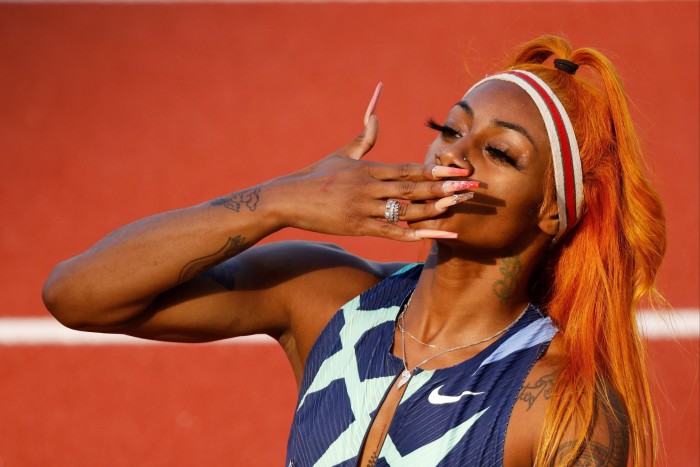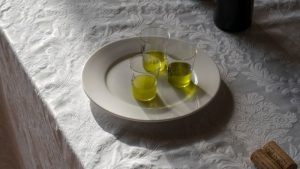On your marks. Get set. Glow?

In September, I had a challenging run at the Berlin marathon. I’d unknowingly come down with a virus, which turned into a fever during the race. Not that you’d know it based on my finish-line selfie, as I looked surprisingly fresh. I was badly dehydrated, but my complexion looked smooth; my chapped lips still tinted. Kudos to Beauty Pie’s SPF 20 tinted moisturiser and Maybelline’s Superstay Matte Ink in pink for the photo finish.
Sport is the ultimate test for a beauty product. Its endurance and efficacy are put through some serious paces, whether the wearer is on the running track, the tennis court or completing a triathlon. Elite athletes and amateurs often undertake their own trials to find their race-day go-tos. And for a beauty brand, there’s bragging rights to be won for creating a cult product that becomes known for its ability to withstand miles of sweat.
Importantly, a race or game-day beauty ritual can help people feel confident and perform at their very best. “It was so important to me to show up as myself on the court,” says Serena Williams, whose pre-and-post-game beauty regime (comprising sheet masks, argan oil hair treatments and a full-body brush with exfoliating gloves) has “empowered” her. Before retiring in 2022, Williams won 23 Grand Slams and four Olympic golds. “Everything from my braids and beads to my winged eyeliner and fashion were part of me,” she says.

Williams is not the only one to find a winner’s mindset within a make-up bag. Sha’Carri Richardson, one of the fastest female sprinters in the world, is renowned for her long painted talons. For the Paris Olympics final in July, her Brooklyn-based nail technician, Angie Aguirre, shipped custom sets of extensions to France; Aguirre had inscribed positivity mottos on each extension that Richardson would see as she touched the track on the starting block. One said “The Chosen One”, another said “You’re Dope”. Richardson glued them on herself.
Meanwhile, WNBA forward Angel Reese, known for her record-breaking number of rebounds, calls herself Bayou Barbie; she uses TooFaced’s lip plumper to keep her smile glossy for games. Manchester United midfielder Ella Toone gets her eyelashes and nails done before matches. CrossFit athlete Danielle Brandon often dyes her long blonde ponytail pink. The Royal Ballet’s principal, Francesca Hayward, loves Murad’s retinol eye cream to “perk my face up” from the late nights on stage, while Team GB’s 2hr34mn marathoner Anya Culling relies on Bondi Sands’ Aero Self Tanning Foam to avoid “pasty” skin. “It doesn’t leave a dreaded pit stain on white kit,” she says, adding: “When I look good, I feel fearless and unstoppable, which is exactly what I want on the start line.”
Women’s sport is more visible than ever. Viewers of the Women’s National Basketball Association in the US and the Women’s Super League in the UK saw record numbers this past year. The Women’s Six Nations rugby was also the most watched season on record, with 8.1mn people tuning into the event via the BBC, according to the Women’s Sport Trust.


More women are also participating: 44 per cent of total runners in the 2024 New York marathon in November were women, with women aged 25 to 29 the largest demographic.
Social media is further amplifying voices. Richardson has 4.2mn followers on Instagram. Simone Biles, the most decorated gymnast of all time, has 12.6mn. Williams has 17.3mn. Each race or match is a spotlight, with camera close-ups and post-match interviews eyeballed the world over.
Women have long been scrutinised in the media for their appearance, which comes with added pressure on game day. Who would want to be barefaced? “If you were going to have one of the biggest moments of your life, you would wear make-up too,” says British Olympic gold sprinter Dina Asher-Smith, citing graduations and weddings as examples. “We train for four years for that moment . . . people are often surprised when I say I wear a full face.”
Struggling with media stereotypes, female athletes have worried whether prioritising their appearance would impact public perception. Speaking on the phone earlier this year, Arsenal forward Alessia Russo told me she felt, as a child, she’d have to be a “tomboy” to be taken seriously in sport.
But the culture is slowly changing. At the Paris Olympics, Yiannis Exarchos, chief executive of the Olympic Broadcasting Services, instructed camera operators to film male and female athletes in the same manner. “Women athletes are not there because they are more attractive or sexy,” he said. “They are there because they are elite athletes.”


Today, cosmetics is a common conversational topic for amateurs and elites alike. My running friends often trade tips about hair (plait ponytails to avoid humidity tangles; get a Tangle Teezer) and sweat-proof sunscreen (Supergoop; Koa). Culling is often asked to give tanning tips. Simone Biles’ “Get Ready With Me” beauty videos, ahead of the Olympic final, went viral, accumulating more than 1.4mn views on TikTok.
Despite the sport boom, few products are formulated or marketed as performance-based. That prompted Williams to launch her own sportproof beauty line, WYN by Serena Williams, in April. The tight edit of products were based on her own gripes while playing. “I needed eye make-up that would last through intense three-hour matches — through all the sweat and movement — so I would [have to] find the most waterproof liquid eyeliner I could get my hands on and apply it to my brows and lashes,” says Williams. She’s since formulated a mascara, a waterproof eyeliner and an SPF 30 skin tint, which is available in 36 shades. “I had to mix foundation shades and add sunscreen [myself] to make my own skin tint” previously. All are designed to go the distance.
This year, the New York Marathon was sponsored by Maybelline — the first time a make-up brand has backed the event. Others are making inroads in other sports. Charlotte Tilbury now sponsors the F1 Academy and has installed “touch-up stations at the racetracks.” Last year, Nike hired London nail artist Jess Young to create 30 sets of extensions painted with a swoosh for the Lioness’ prematch manicure, while Arsenal women’s team has a partnership with US cosmetics company Il Makiage. Venus Gillette also enlisted Arsenal players for a 2023 campaign, after studies found more than a third of women in the UK don’t participate in sport because they’re self-conscious about how their skin looks in shorts.
There’s scope for greater representation in marketing. Data from influencer marketing company Lefty shows that female athletes’ engagement rates surpass their male counterparts, at an average of 14.3 per cent. Yet male athletes get more advertising campaigns — see the likes of Lewis Hamilton for Dior or Marcus Rashford for Burberry. Juventus forward Alisha Lehmann regularly posts about beauty to her 17mn Instagram followers, but, according to Lefty, she’s yet to even have a sponsored make-up ad on Instagram.

“Sportswomen have been significantly under-represented to date,” says Tilbury. Asher-Smith agrees, attributing it to historical perception of female athletes as “mini” versions of men. But the “hard work, sacrifices and commitment women athletes make” for their sport, and themselves, is a powerful narrative for a company to get behind, she believes.
Beauty has a role to play in not only supporting this generation of sportswomen, but motivating the next. “There is so much opportunity for athletes and [beauty] brands to tell inspiring stories,” says Williams, “both on and off their respective courts.”
Sign up for Fashion Matters, your weekly newsletter with the latest stories in style. Follow @financialtimesfashion on Instagram and subscribe to our podcast Life and Art wherever you listen
#marks #set #Glow





